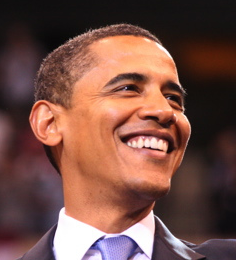A look at Obama's IT strategy: The Facebook connection and the scale challenge

Barack Obama has sealed the Democratic party nomination with the help of social networking, a Facebook staffer and an off-the-shelf IT strategy.

Carr, who has parachuted in on the IT strategies of MySpace and Google to name a few, also has an interesting perspective given he's an Obama volunteer too. Carr has a long detailed case study, but here are some of the technology takeaways:
Obama kept his IT strategy simple. The campaign didn't customize heavily and it didn't look for bleeding edge technology. It used the same stuff the rest of the blogging world does--Movable Type, PHP, MySQL with a dose of community. The competitive advantage came from using social networking to "empower a highly decentralized, largely self-organizing, network of volunteers," reports Carr.
He found a few community experts. According to Carr:
The Obama campaign has Chris Hughes, who was one of the three co-founders of Facebook and now runs the campaign's my.barackobama.com, which itself is a sort of social network. Hughes is not a software developer (it was his Harvard roommate Mark Zuckerberg who wrote the original Facebook code), but he brought an appreciation how to nurture and manage online communities.
Decentralize the workforce (in this case volunteers) and give them autonomy. Obama's campaign is the typical manage from the bottom up approach. This has enabled volunteers organize in states even when he hasn't directly targeted those areas.
Scaling is always a challenge. Exhibit A is an application--provided by a consulting firm Blue State Digital--that the Obama campaign uses to make phone calls from home--a critical capability since the campaign relies so heavily on volunteers. Carr reports:
One key application that Blue State provided is the tool for making phone calls from home. It was a new component of the software suite, so it was "in pretty rough shape when I got here," Hughes says, and has gone through "all sorts of modifications" to make it more useful, including tools for better management of the scripts and lists, and better back-end integration with voter databases.
In its default interactive mode, the tool presents the first name and phone number of a person to call, and sends the user down a different path through the call script depending on whether the volunteer reaches the voter, and, if so, whether that person likes or dislikes Obama or is undecided. Volunteers also record bad and disconnected numbers, which helps to clean up the voter list for future use.
One important improvement has been the ability to preview the script (including all its conditional branches) so the volunteer can run through it before starting to make calls. Alternatively, if the volunteer has a shaky Internet connection, or the Web site is overloaded and responding slowly, the site lets users print the script and a list of numbers to call offline, then post the results of those calls later.
Scalability, however, has sometimes been a problem. In the days leading up to February's Super Tuesday primaries, the phone banking tool "was completely overwhelmed to the point where it was almost useless," says Michael Spitzer-Rubenstein, a campaign volunteer from Los Angeles.
Can these systems hold up in a general election? Carr noted that data management will become a problem for Obama now that his campaign will have to hook up with the Democratic national campaign. One software and quality assurance pro said that she sees flaws in the Obama systems that could become a problem in the general election. The biggest issue: The campaign switches between two or three different systems to track voter contact. Bottom line: Data integrity will be an issue.
But like any other startup, Obama's campaign will have to figure out how to scale quickly and handle peak loads.